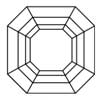|
Asscher Cut is NOT a Square Emerald Cut
|
|
On Tuesday, November 7, 2017
|

 Many people believe that the Asscher cut diamond is simply another term for the square emerald cut diamond, but this is not correct. This misunderstanding occurs partly because the Asscher cut is named after a brand, so people assume that the square emerald cut is the “correct” name. Both the Asscher cut and the square emerald cut display sparkling step-cut faceting with a vintage style, but while they may look similar at first glance, there are several significant differences between the two cuts.
Many people believe that the Asscher cut diamond is simply another term for the square emerald cut diamond, but this is not correct. This misunderstanding occurs partly because the Asscher cut is named after a brand, so people assume that the square emerald cut is the “correct” name. Both the Asscher cut and the square emerald cut display sparkling step-cut faceting with a vintage style, but while they may look similar at first glance, there are several significant differences between the two cuts.
History
The emerald cut has been a popular cut for diamonds and gemstones for hundreds of years. It started as a variation of the table cut, the earliest cut of gemstones which dates back to the 1500s – early stone cutters found that the emerald cut lowered the pressure during the cutting process, reducing the risk of chipping the gemstone. The name “emerald cut” was first coined during the Art Deco period in the 1920s when it was a particularly popular cut for emeralds and its symmetry and clear-cut lines aligned with the current fashion.
The Asscher cut was also popular during the Art Deco period, having been designed and patented in 1902 by Dutch diamond artisan Joseph Asscher. Joseph came from a renowned family of diamond artisans – his grandfather founded the Asscher Diamond Company in Amsterdam in 1854, and his brother Abraham was commissioned by King Edward VII of England to cleave the 3,106 carat Cullinan Diamond, the largest diamond ever found at that time.
Shape
Both the square emerald cut and the Asscher cut are step cut stones. Only square and rectangular stones can be step cut as these feature straight lines running parallel to the diamond’s side. The traditional emerald cut diamond is a rectangular shape, while an Asscher cut is a square shape. This creates another point of confusion, as people assume that any square emerald cut must automatically be an Asscher cut.
Comparing Cuts
The original Asscher cut and the square emerald cut both have 58 facets, which explains in part why there is some confusion between them. Both cuts are guaranteed to capture the light of a gemstone through their multi-faceted design. They are best suited to highlighting diamonds and gemstones of exceptional cut and clarity, as any flaws will be easily detected.
The Asscher cut consists of a square cut diamond with chopped corners, giving the stone an almost octagonal appearance. In contrast, the corners of the square cut emerald are not so deeply cut, so it is more of a full square. The original Asscher cut has a three step crown and a seven step pavilion and the 58 facets are larger and wide-set compared to the square emerald cut. The Asscher also has a smaller table and higher crown height that the square emerald cut.
In the early 2000s, the Royal Asscher Company updated their famous cut to the new internationally patented “Royal” Asscher cut, giving it 74 facets. Edward Asscher added two more rows of eight facets each to the base of each stone, This cut enables the stone to catch great deal more reflected light, highlighting the stone’s brilliance.
The Ultimate Difference
The Royal Asscher cut is an internationally patented term so the Royal Asscher Company can limit the range of angles used in cutting a stone, and is the only company entitled to cut a Royal Asscher stone. An authentic Royal Asscher Cut diamond is inscribed with the Royal Asscher Cut logo and a unique identification number, confirming that the diamond is conflict free, natural and untreated.
A multi-faceted square emerald cut will have subtle differences in cut to an authentic Asscher cut, but the most compelling difference would be the lack of proof of authenticity. While the Asscher
|
|
|
|
Tags: asscher cut, loose diamonds, emerald cut
|
|
Category: Diamonds
|
|

|
|
